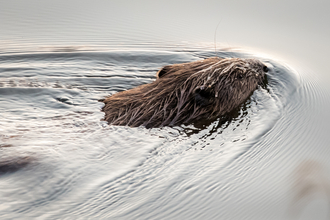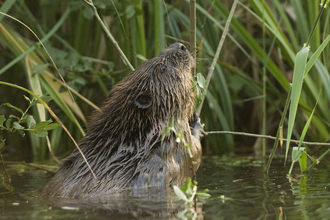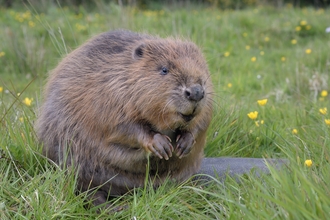Beavers
Europe’s largest rodent, the beaver is the size of a tubby spaniel. Beavers are among the world’s best natural engineers, and the dams they build divert and slow down running water, creating a mosaic of pools and marshes, wet woodland, and flooding ‘canals’ that they use to reach tasty young willow growth. Tragically, the beaver became extinct in the UK in the 16th century; hunted for their fur, meat, and for the oil in their scent glands, which was used in medicine. With the loss of the beaver, one of the great architects of the countryside, our wetlands became all the poorer. The Wildlife Trusts are at the forefront of bringing beavers back.
The beaver’s ability to create new wetlands and restore native woodland is tremendous
Find a beaver
The return of beavers is the first formal mammal reintroduction in UK history. Re-introduction trials and projects are underway or planned in England, Scotland and Wales.
In February 2025 the UK Government announced that beavers were allowed to live wild in English rivers for the first time in centuries. This paves the way for beavers to roam wild in British rivers and lakes once more!
Read more about the Wildlife Trusts' beaver projects, and find out where you can see beavers below.
Scotland
In May 2009, the Scottish Beaver Trial released the first beavers to live wild in Scotland in over 400 years. This marked the first ever formal reintroduction of a native mammal species in Britain and launched a groundbreaking five year study to explore how beavers can enhance and restore natural environments.
There is no enclosure and the trial area covers 44 square kilometres. The successful five year trial led to a decision by the Scottish Government in 2016 to allow beavers to remain in Scotland! In 2019 the Scottish Government announced legislation giving beavers legal protection, granting them Protected Species status. Current population estimates are at around 2,000. In 2022, the national Scottish Beaver Strategy was published, setting out how to help beavers become established throughout Scotland’s lochs, burns and rivers, and the many ways that both people and wildlife will benefit from their presence.
Keep up to date on this project at scottishbeavers.org.uk
A visit to the ‘beaver detective trail’ in Knapdale should reveal plenty of tracks and signs. Visit early in the morning and you may be lucky enough to see a beaver!
England
Devon
In 2011, an enclosed trial started in Devon. This is a closed site with no formal access, but you can see them along the River Otter, after Devon Wildlife Trust successfully argued for a wild beaver trial when five wild beavers of unknown origin were discovered on the River Otter in 2015. The UK Government's original plan was to capture the animals and rehome them, but the animals were instead monitored over a five year period.
In August 2020 the Government announced that Devon's beavers could stay - and spread naturally into other river catchments. This was a landmark decision and one of the most important moments in England's conservation history: the first legally sanctioned reintroduction of an extinct native mammal to England. It was the first legally sanctioned reintroduction of an extinct native mammal to England.
Public access to view wild-living beavers is possible via stretches of public footpath alongside the River Otter. May to August is the best time to visit. Devon Wildlife Trust runs a series of public guided beaver watching visits to the River Otter each spring/summer – see their What’s On pages for details.
Kent
In Kent, beavers have been present at Ham Fen since 2001. Although the reserve is not open to the public, you can make an appointment for a group visit, and Kent Wildlife Trust runs regular guided walks, giving the opportunity to see these water engineers at work. Keep an eye out on their events page for Beaver Evening dates.
Cornwall
In Cornwall in June 2017, two beavers were released into an enclosure along a stream above Ladock, a village increasingly affected by flooding. The Cornwall Beaver Project team, consisting of staff from Cornwall Wildlife Trust and Woodland Valley Farm, worked with researchers from the University of Exeter, who installed specialised equipment over a year before the beavers were in place, monitoring the flow of water through the site.
Guided beaver walks in Cornwall
Derbyshire
Derbyshire Wildlife Trust introduced beavers to their Willington Wetlands reserve in September 2021. A female and male from two releases paired up and had their first kits in July 202.2. This breeding couple have since had approximately two kits every year!
The family of beavers have shaped and improved the site from coppicing trees and shrub species, damming smaller water courses and creating beaver canals. These have been instrumental in creating diverse and dynamic wetlands, having benefits to Red and Amber List species like curlew and lapwings, as well as kingfishers and harvest mice.
Nottinghamshire
In 2021 Nottinghamshire Wildlife Trust introduced beavers into an enclosed section of Idle Valley Nature Reserve. This is one of the largest beaver enclosures in the UK!
Essex
Essex Wildlife Trust has been supporting Spains Hall Estate, Finchingfield, for the past three years since their release of a pair of Eurasian beavers to a secure beaver enclosure.
Wales
The Welsh Wildlife Trusts are leading the Welsh Beaver Project and are currently investigating the feasibility of releasing beavers.
What to look out for
The young beavers, known as ‘kits’, emerge from the lodge at the end of the summer, and can be seen out and about feeding with their parents through the autumn. While they are known for eating trees, during the summer they also feed on aquatic plants, grasses and shrubs, resorting to more woody plants in the winter. The presence of beavers and their dams also improves conditions for a wide range of species including dragonflies, otters and fish, so expect plenty of other wildlife around!
If you can't get to these places
There is some great film footage of Devon’s beavers including the first wild kits! Check out the video below or see plenty more on Devon Wildlife Trust’s YouTube channel.







